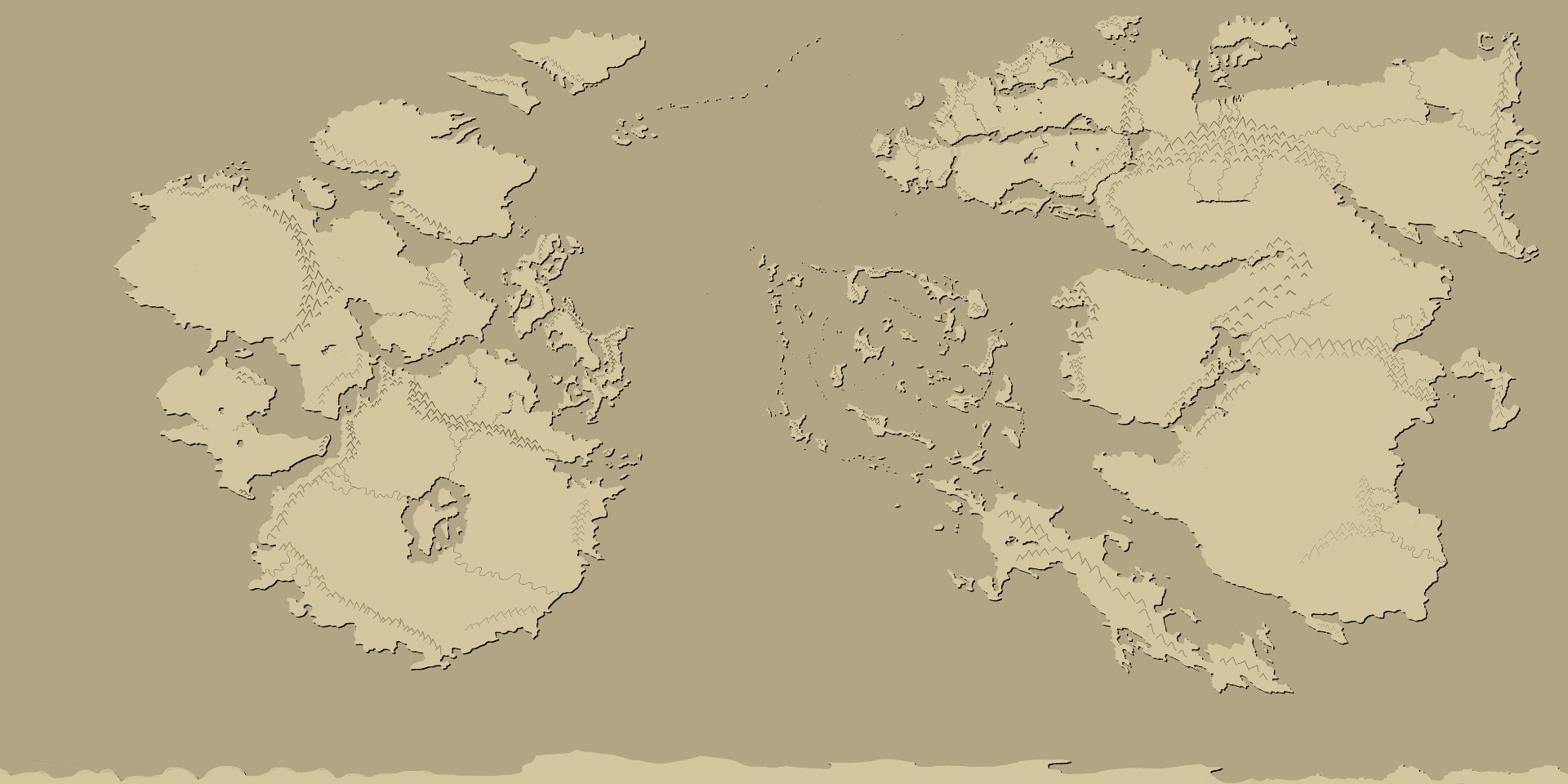
Damage system
Damage system
Damage
is divided into three types,
Light, Extensive and
Critical as well as the subtype Bleeding.
The basic mechanic is that a character can withstand a certain amount of damage from each type based on the characters total HP. If the damage taken is of the light or extensive type, when the total amount surpasses the the maximum value, the counter resets and starts counting again. Every time the counter goes back to zero, a point of damage for the type above is generated.
Light
damage comes from unarmed,
stunning and superficial damage, resulting in scrapes,
scratches and bruises. When the max amount of light damage is surpassed, one point of extensive damage is generated
and a roll of 3d6 is made against the Trauma threshold. If this roll fails, the character is passed out. The amount of light damage a character
can take is equal to the total amount of HP. Light damage heals at a rate of (CON/4) per day.
Extensive damage comes from penetrating and major blunt damage. All melee weapons
and ranged weapons (with exceptions like a sap) deal extensive
damage. The amount of extensive damage
taken also leads to bleeding (see Bleeding damage). When the max amount
of damage is surpassed, a point of critical damage
is generated. The total amount of extensive damage
a character can take is (HP/2) and heals at a rate of (CON/4) per week.
Critical damage is the highest
and deadliest form of damage.
Critical damage comes from accumulated extensive damage or supernatural damage.
Every time a character takes a point
of critical damage, a roll against Trauma threshold is done to see if the character passes out. The difficulty is based on the amount of critical damage
the character has taken (example; a character has taken two (2) points
of critical damage,
therefore a roll of 2d6 is rolled against
Trauma threshold). Should
the character reach its maximum
amount of critical
damage, the character dies. A character has (HP/3) amount
of max critical damage. Critical
damage heals at a rate of (CON/4) per month.
Bleeding damage is a secondary damage type that is counted by turn and is generated from taking other kinds of damage. When ordinary damage is taken a certain amount of points is added to bleeding rate, which at the end of the turn becomes bleeding damage which counts towards the characters maximum threshold amount (HP). When the threshold is reached one point of extensive damage is generated and the total amount goes back to zero again. When a point of extensive damage is generated from light damage, one point of bleeding rate is added. When a point of critical damage is generated from extensive damage, ten points of bleeding rate is added.
Bleeding damage heals at a rate of (CON/4)
per hour, the bleeding rate goes down (CON/4) per 10 min.
Example of damage; An ordinary gentleman is attacked by a ruffian with a knife and receives a cut which does eight (8) extensive damage (2D6, rolled 5+3=8). Half of this, four (4), is added to bleeding rate. The gentleman has a HP of twenty (20), which is also his threshold for bleeding damage. At the end of the turn he takes four (4) bleeding damage. Unless he takes more damage, it would take five (5) rounds for that bleeding to reach the threshold and as such generate one (1) point of extensive damage.
Bleeding rate; The amount of total bleeding damage taken per turn is set by the bleeding rate. Depending on the type of damage taken it generates different amounts of bleeding rate. For every ten (10) points of light damage taken, one point of bleeding rate is generated. Half of the amount of extensive damage is added to bleeding rate. Critical damage add double the amount to bleeding rate.
Poison generates extensive damage. The amount taken is dependent on the intensity of the source. Most poison does damage over time while burning damage only occurs as long as the character is exposed to the source. How long a character is poisoned depends on the sort of poison and the dose. When being poisoned, a roll is made against CON with a difficulty depending on the type of poison. A successful roll means that the character's body resists the poison and no more damage is taken. A failed roll means the poison remains in the body and continues to hurt the character. Another roll against CON is made every time the poison does damage, until a successful roll is made. A critical success means that the body fully rejects the poison and takes no damage while a critical failure means the body has no resistance and the full length of the poison's duration is suffered (no more rolls against CON can be made for this poison).
Whenever damage of these types is taken, a roll against
CON is made. A successful roll halves the damage taken, while a failed
roll means that the full damage is taken. A critical success
means only 1/10 of the damage is taken while a critical failure
means the damage
is doubled.

Examples of poisons and venoms, severity, and damages
Infection is a risk anytime extensive damage is taken. Any open wound, no matter how small can still become infectious and lead to serious consequences. So long as a character has any point of extensive damage, a roll must be done towards CON each day. Base difficulty is normal (3d6) for any wound. Difficulty modifiers come from wound treatment or the negligence of it, if the cause of the wound was clean or dirty, and the like (GM decides). A cared for wound that is properly cleaned and covered lowers the risk of infection, while ignoring or mismanaging the wound will increase the risk. As long as the daily roll against CON is successful, no infection will settle in a wound. A failed roll however means that an infection has taken hold and the body will start to react.
On the day that the roll is failed, no healing will occur as the infection begins to fester the wound. Treating the wound at this point will not mitigate the effect but will reduce difficulty for the next roll. If the CON roll fails the next time, the infection is starting to spread and the character takes 1d6 extensive damage. At this point another CON roll is made (normal difficulty, 3d6) to see the extent of spread. A successful roll means that the body is containing the infection to the wound, while a failed roll means that the infection is spreading and the character starts developing more symptoms such as fever, which has to be treated separately from the wound, and any roll made towards CON for infection is one (+1d6) level harder, even with treatment.
At this point, so long as rolls against CON are successful healing can occur. Failed rolls however will continue to add damage.
When extensive damage generates critical damage, it means that the infected wound is turning necrotic and requires medical care to treat. When treated a roll is made against CON, difficulty based on the amount of critical damage (one point critical equals one die). If the roll is a success the necrotic damage is contained but leaves a nasty scar. A failed roll means that the necrosis remains until the next medical treatment where a new roll against CON is made. A critical fail means that the necrosis has gone too far and needs very invasive treatment. If it's a limb it has to be amputated to stop the necrosis. If the wound is on the torso, a major surgery to remove any soft tissue, including organs, that have become necrotic. Rolls for treatment are done against the Medicine skill. Amputation is a hard (4d6) roll. The surgery is a very hard (5d6) roll.
Amputation happens mainly in two ways, either through excessive damage or by medical action. With damage an amputation happens if one or more critical points of damage is taken from one single hit. A roll is made against strength with difficulty equal to the amount of critical damage taken. If the roll succeeds then no amputation occurs. A failed roll means that amputation occurs and a roll against trauma threshold equal to points of critical damage must be made to see if the shock kills the character. If the rolls succeeds the character is alive. A critical failure against strength means that amputation occurs and the character dies instantly from shock.
Medical amputation requires a roll against the Medicine skill. Any amputation done will give the patient both critical damage and bleeding. A successful roll means that the amputation succeeded, the patient takes one point in critical damage and 2d6 bleeding. A roll against medicine is then done to close the wound. If the roll perfect there is no need for a second Medicine role to close the wound. A failure means the procedure was done badly without successful amputation which leaves a nasty wound. The patient takes one point of critical damage and 2d6 of bleeding. A critical failure to amputate badly maims the patient, giving him 1d6 critical damage and 3d6 bleeding, possibly even getting the medical instrument stuck in the patient.
Muzzle
proximity damage
When firing a ranged weapon at a target in close proximity of the muzzle (touching or nearly touching), instead of rolling for damage, the full potential amount of damage can be applied directly instead of rolling. Example, a small caliber pistol with a caliber doing 2D6 damage will at point blank do 10 damage unless rolled (5+5=10, sixes are counted as exploding and not a set value).
Bullet types generally come in one of three varieties; Solid lead, jacketed and hollow-point. While other sorts might exist, these are the most common.
Solid
lead,
also called cast bullets is the most used and easily available type of
bullet. Depending on the weapon, it may use either soft of hard cast bullets.
The cast bullet, depending on the hardness, will carry most desired properties
one might have for a bullet. A downside is however that a cast bullet can leave
a fouling in the barrel which needs to be cleaned more often. If the fouling
builds up too much it will cause problems, at best negatively impacting
accuracy and at worst causing a barrel obstruction, which can make the barrel
explode if another shot is fired. One way to mitigate the lead fouling is to
use less propellant
Jacketed bullets have a soft lead core encased
in an outer shell
made of a harder metal, usually a copper
alloy. Because of this the bullet
can manage higher
velocities, which in turn offers
higher penetration
value at the cost of damage done. A
jacketed bullet also does not leave a lead fouling like a cast bullet. The
downside is however that the bullet is more expensive and not readily available
for purchase as a cast bullet.
Hollow-point has, as the name suggests, a hollowed out top or point. A hollow point bullet may be made as a cast bullet or as jacketed type bullet, the later then called jacketed hollow-point. The reasoning behind the hollow-point bullet is to increase damage done, by intentionally having the bullet deform, or mushroom, as it hits a target and thus creating a larger wound, but with the drawback of reduced penetration. As with a regular jacketed bullet, the jacketed hollow-point is more expensive than the cast variant and is not as readily available.
Soft-Point bullets are a variant of the jacketed hollow-point
where instead of the point being hollowed, it is a soft lead top, meaning that
the soft lead core is unjacketed and forms the tip of the bullet. The effect is
similar to the hollow point version, meaning that the bullet expands when
hitting its target and causing a larger wound but at the cost of penetration.
